

Asymptomatic. Patient is a carrier for a disease or infection but experiences no symptoms Pulmonary contusion due to trauma is an example of a condition that can be asymptomatic with half of people showing no signs at the initial presentation.
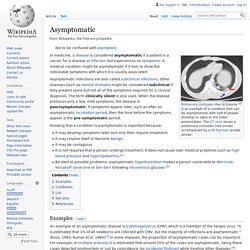
The CT scan shows a pulmonary contusion (red arrow) accompanied by a rib fracture (purple arrow). In medicine, a disease is considered asymptomatic if a patient is a carrier for a disease or infection but experiences no symptoms. A medical condition might be asymptomatic if it fails to show the noticeable symptoms with which it is usually associated. Asymptomatic infections are also called subclinical infections. Knowing that a condition is asymptomatic is important because: It may develop symptoms later and only then require treatment.It may resolve itself or become benign.It may be contagiousIt is not required that a person undergo treatment. Examples[edit] 2020.12.12.422516v1. SARS-CoV-2 RNA can be reverse-transcribed. As the coronavirus disease 2019 (COVID-19) pandemic continues to take its toll on human life and economic activity, reports have emerged about the repeated positive tests and continued shedding of the virus for weeks and months after clinical recovery.
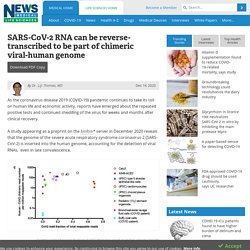
A study appearing as a preprint on the bioRxiv* server in December 2020 reveals that the genome of the severe acute respiratory syndrome coronavirus-2 (SARS-CoV-2) is inserted into the human genome, accounting for the detection of viral RNAs, even in late convalescence. Scatter plot showing human-CoV2 chimeric read number. Image Credit: Reinfection or reverse transcription? Multiple cases of apparent reinfection have been reported over the past year. Steam inhalation therapy found to inactivate SARS-CoV-2 virions. Over 61.49 million people worldwide have been infected with severe acute respiratory syndrome coronavirus 2 (SARS-CoV-2) – the agent that causes coronavirus disease 2019 (COVID-19) – and over 1.44 million people have lost their lives.

At present, there are no safe and effective antivirals to treat infection. Non-pharmaceutical interventions (NPIs) thus remain the order of the day, and these typically include wearing masks in public, social distancing and regular handwashing. Nearly a year on from when the virus was first detected, Italian researchers at the Biochemistry and Pharmacology Laboratory, Meyer Children's University Hospital, Florence, Italy, have published a study on the efficacy of steam inhalations as another possible treatment to help mitigate SARS-CoV-2 infection.
Their study was published in the latest issue of the journal Life Sciences. Background and objectives of the study The virus and the way it infects Temperature. Thermal inactivation of SARS COVID-2 virus: Are steam inhalations a potential treatment? 1.
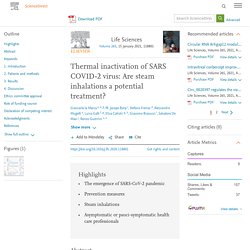
Introduction The new coronavirus (SARS-CoV-2) causing COVID-19 is an RNA virus coated with a capsid and a peri-capsid crossed by glycoprotein structures. The external proteic structure, which attacks human cells, is a potential target to therapeutic interventions against virus replication in airways. Since high temperature can cause irreversible denaturation of proteins and loss of SARS CoV and SARS CoV-2 infectivity was obtained after heating at 56 °C for 15 and 30 min in liquid environments respectively [[1], [2], [3]], we designed a simple protocol aimed at damaging SARS-CoV-2 capsid through steam inhalation cycles.
Although the ominous consequences of COVID 19 infections has directed medical attention toward solidly established medical approaches, the European Pharmacopoeia VI edition also quotes steam inhalations as a procedure to treat of respiratory diseases [4]. 2. Seven out of 10 subjects met the inclusion criteria (nos. 1–7). 3. Higher BMI linked to increased risk of SARS-CoV-2 infection. Persistent SARS-CoV-2 infection and viral evolution tracked in an immunocompromised patient – COG-UK Consortium. In recent work from COG-UK consortium investigators, released as a pre-print, Professor Ravindra Gupta and colleagues investigated SARS-CoV-2 evolution in a single immunosuppressed individual treated with convalescent plasma.
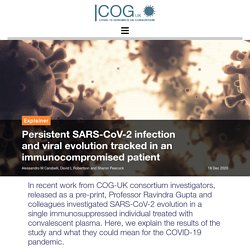
Here, we explain the results of the study and what they could mean for the COVID-19 pandemic. All viruses, including SARS-CoV-2, accumulate mutations as they evolve over time. Most mutations have no detectable effect on the biology of the virus. But a few have the potential to change the virus in minor ways and be spread to other hosts. But what are the drivers of viral evolution, and could antibody treatment have any influence on this process? Covid-19 Skin Conditions. Small bumps on the tongue identified by doctors as a potential symptom of coronavirus. Small bumps on your tongue have been identified as a possible symptom of the coronavirus.Researchers say rashes in the mouth should be recognized as a sign that a patient has Covid-19.

The study looked at hundreds of patients at a temporary field hospital who were treating patients like the coronavirus Madrid, Spain. The average age of the patients was 56 years old and 58% of them were female, reports the Sun. Slightly less than half of the patients presented with a mucocutaneous manifestation (immunodeficiency syndrome), the hands and feet being particularly affected. But a quarter of patients had a rash inside the mouth – the most common being transient lingual papillitis – which is manifested by small red or white bumps on the tongue.
This follows a study by King’s College London and the British Association of Dermatologists which has also linked rashes to the coronavirus. “We found that one in six children had a rash without any other classic symptoms. Enanthem in Patients With COVID-19 and Skin Rash. Recalcati1 recently reported skin manifestations in 18 patients in Italy with severe acute respiratory syndrome coronavirus 2 (SARS-CoV-2) infection, or coronavirus disease 2019 (COVID-19), describing “erythematous rash,” “widespread urticaria,” and “chickenpox-like vesicles.”
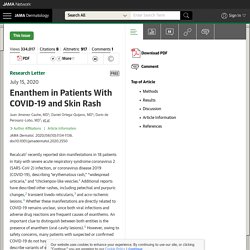
Additional reports have described other rashes, including petechial and purpuric changes,2 transient livedo reticularis,3 and acro-ischemic lesions.4 Whether these manifestations are directly related to COVID-19 remains unclear, since both viral infections and adverse drug reactions are frequent causes of exanthems. An important clue to distinguish between both entities is the presence of enanthem (oral cavity lesions).5 However, owing to safety concerns, many patients with suspected or confirmed COVID-19 do not have their oral cavity examined. Further evidence highlights mouth, lip, and skin lesions as signs of COVID-19 - BAD Patient Hub. The results of a study published as a research letter in the British Journal of Dermatology today, provide further evidence to support the case that oral lesions and skin rashes, also known as mucocutaneous manifestations, are an important sign of COVID-19.
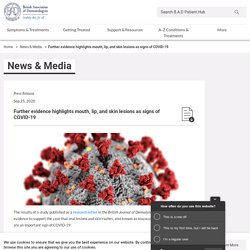
The study included 666 COVID-19 patients with mild to moderate pneumonia, being treated in a temporary field hospital set up during the pandemic’s peak in Madrid, Spain. The mean age of the patients was 56, 58% of them were female. Forty-six per cent of patients had some form of mucocutaneous manifestation, with issues with the skin on the hands and feet being particularly common (40%), as well as findings inside the mouth (26%). The most common hand and foot issue was diffuse skin peeling (25%), and most common issue found in the mouth was transient lingual papillitis, also known as lie bumps, characterised by the appearance of small red or white bumps on the tongue. Prevalence of mucocutaneous manifestations, oral and palmoplantar findings in 666 patients with COVID-19 in a field hospital in Spain. - X-MOL. A Nuno-Gonzalez,P Martin-Carrillo,K Magaletsky,M D Martin Rios,C Herranz Mañas,J Artigas Almazan,G García Casasola,E Perez Castro,A Gallego Arenas,A Mayor Ibarguren,M Feito Rodríguez,B Lozano Masdemont,M Beato,E Ruiz Bravo,P Oliver,M D Montero Vega,P Herranz Pinto.
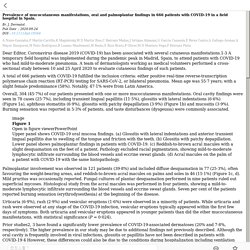
Multisystem inflammatory syndrome in children and adolescents temporally related to COVID-19. As of 15 May 2020, more than 4 million confirmed cases of COVID-19, including more than 285 000 deaths have been reported to WHO.
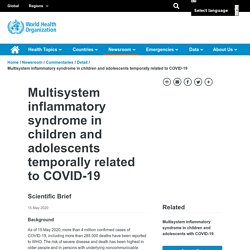
The risk of severe disease and death has been highest in older people and in persons with underlying noncommunicable diseases (NCDs), such as hypertension, cardiac disease, chronic lung disease and cancer.1-4 Limited data describe clinical manifestations of COVID-19 that are generally milder in children compared with adults,5-8 but also show that some children do require hospitalization and intensive care.9-11 Relatively few cases of infants confirmed to have COVID-19 have been reported; those who are infected have experienced mild illness.7 Robust evidence associating underlying conditions with severe illness in children is still lacking.
It is essential to characterize this syndrome and its risk factors, to understand causality, and describe treatment interventions. 9/27/20: CDC Pressured from Top Down to Change Testing Guidance. "It's coming from the top down," the official said of the new directive from the Centers for Disease Control and Prevention. White House coronavirus task force member Dr. Anthony Fauci said he was in surgery and not part of the discussion during the August 20 task force meeting when updated guidelines were discussed. "I was under general anesthesia in the operating room and was not part of any discussion or deliberation regarding the new testing recommendations," Fauci, director of the National Institute of Allergy and Infectious Diseases, told CNN Chief Medical Correspondent Dr. Sanjay Gupta. "I am concerned about the interpretation of these recommendations and worried it will give people the incorrect assumption that asymptomatic spread is not of great concern.
The new guidelines raise the bar on who should get tested, advising that some people without symptoms probably don't need it -- even if they've been in close contact with an infected person. CDC Director Dr. Dr. New York Gov. Coronavirus: Iceland’s mass testing finds half of carriers show no symptoms. As the coronavirus pandemic surges worldwide, each piece of data counts in the fight against the deadly pathogen.
But significant findings about the contagious disease are coming from an unlikely place: Iceland, the tiny Island state with a population of just 364,000 people, where authorities are testing large numbers of the population – without imposing any lockdown or curfew. Read more: The coronavirus test you don’t know about, but should: Experts Coronavirus: WHO chief says ‘Test, test, test’ Social distancing flattens coronavirus curve, but outbreaks might not be over: Expert As of Sunday night, the country’s health authorities and the biotechnology firm deCode Genetics have tested more than 10,300 people.
But it is not just the numbers of people being tested that is unusual about Iceland’s approach. Symptoms of coronavirus (COVID-19) Novel Coronavirus 20.21. Novel Coronavirus Pandemic Proportions. Novel Coronavirus.